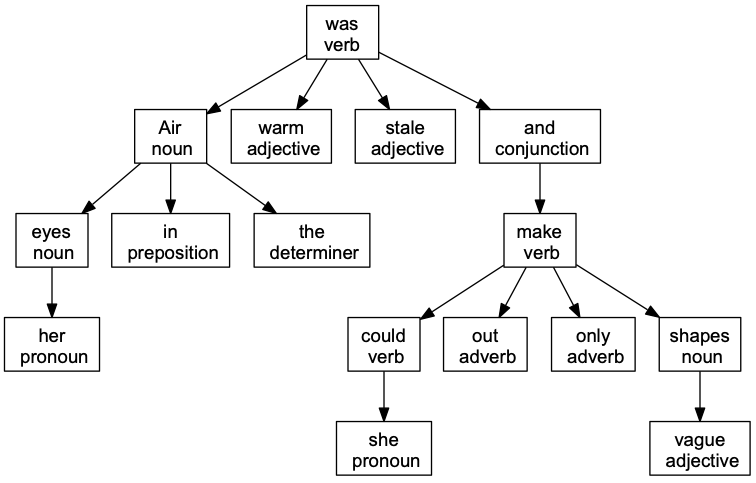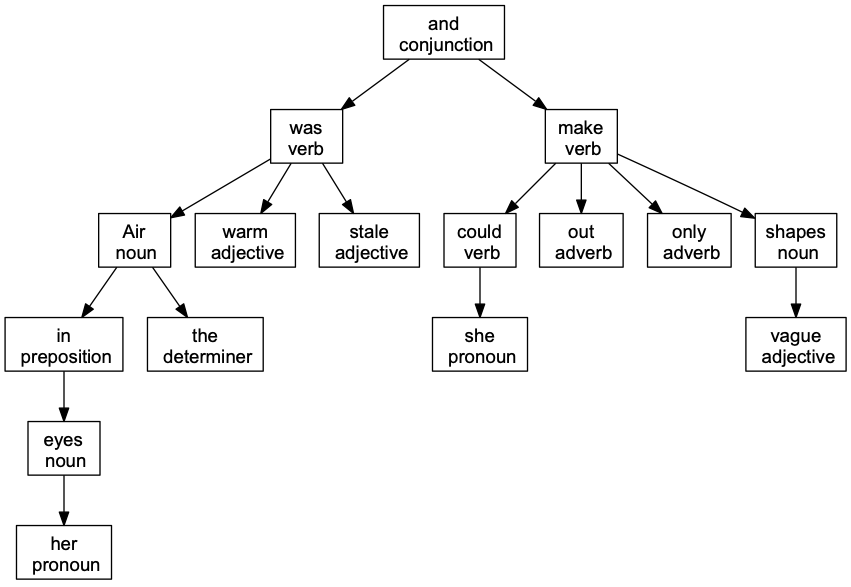I have revised the tree to fix the problems you pointed out:
i think explaining your changes, or thoughts about each thing i mentioned, would help.
Quoting the sentence:
The Air in her eyes was warm, stale, and she could make out only vague shapes.
Elliot wrote:
There are a few issues, including:
air (n) → her (n)
why do you have a noun as a child of a noun? what does that mean?
You’re right. That doesn’t make sense. The “air” should be under “in” because that’s the preposition relating “eyes” to “air”. The “her” is modifying eyes telling us whose eyes the air was in.
make (v) → she (n)
“she make …” is not grammatical. it’d be “she makes …” if those were the subject and verb. that indicates that something’s wrong there. (the issue in this section is partly stylistic and there’s disagreement about the best way to do it.)
The sentence sez:
she could make
The word “could” is a helper verb modifying “make” putting it into the past tense and indicating that the sentence is about what she was able to make out.
was (v) → and (c)
this is partly stylistic and people disagree about the best way to do it, but if you were making the tree with lisp s-expressions you’d do (and (was …) (make …)) not (was … (and (make …)))
If the idea is that I should identify the main verb first then “was” should be the top of the tree. But “and” does join the clauses and so it is acting on both of the verbs so that is reason to put it at the top of the tree.
I have revised the tree again to reflect those changes:
Yeah that’s better. FYI “her” isn’t a pronoun here because it’s a modifier not a noun.
It’s unclear whether “was” is the main verb of the overall sentence because “and” is a coordinating, not subordinating, conjunction. That means it combines things of approximately equal importance. Some people make trees with conjunctions in different ways, but in short I prefer clearly showing the structure, with how clauses are combined, similar to how a lisp program would. And I generally avoid nesting a clause inside another clause, which I think is unnecessarily complex and diminishes the importance of clauses as major units. So I prefer only to nest clauses when they’re more clearly playing a small role, like in “I want to buy the car that I like.” In that sentence, the clause “I like” is playing a modifier role (telling us which car) rather than as big a role as a coordinate clause or typical subordinate clause joined by a subordinating conjunction (for example “I want it because I like it.” shows a typical subordinate clause that I wouldn’t want to nest under the main clause in my tree. I’d put “because” as the root.).
I believe that technically “make” is an infinitive and “could” is the verb for that clause, but the “helper/auxiliary verb” view is common and works ok (but doesn’t got into a tree as cleanly, e.g. in this case you have the subject, “she”, split from what you present as the main verb. For a good reason that I pointed out above. But it’s also problematic to say something is the main verb and then not directly give it a subject. But it’s alright. It depends on your goals. There are lots of ways to do it that can help you understand the sentence and be reasonable even if IMO imperfect. If you want to get really advanced with this stuff, the best thing is to understand multiple ways of doing it, not just the one you think is best.)
You can put “she” as a child of “make” and also “could” as a child of “make”. That’s conceptually accurate but not grammatically accurate. If “make” is the main verb, then “she” is its subject. “could” is some kind of modifier of “make”, in this case a helping verb.

